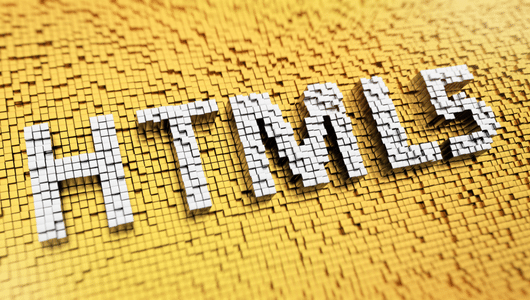What Is HTML5?
HTML5 is the current web development standard, quickly becoming the go-to choice for developers worldwide. HTML5 is a markup language designed to improve upon its predecessors in several ways. One of the most significant benefits of HTML5 is its ability to create rich and interactive web experiences without additional software or plugins.
HTML5 was developed to address the limitations of previous versions of HTML. For example, HTML4 could not natively create multimedia content, relying on third-party plugins like Adobe Flash. However, HTML5 offers built-in support for multimedia elements such as audio, video, and canvas, making creating engaging content easier without additional plugins.
Another significant benefit of HTML5 is better support for mobile devices. As mobile devices became more popular, developers needed a way to create web experiences optimized for smaller screens and touch input. HTML5 provides a more streamlined and efficient way to create mobile-friendly websites that are responsive and optimized for a wide range of devices.
Overall, HTML5 offers a range of benefits that make it the go-to choice for modern web development. From multimedia support to improved accessibility, HTML5 is a versatile and powerful tool that enables developers to create web experiences that are engaging, interactive, and accessible to a wide range of users.
Importance of HTML5
HTML5 has become increasingly important in today’s digital landscape as the world becomes more dependent on the Internet. Websites and web applications are now more sophisticated than ever before, and HTML5 plays a crucial role in their development. In fact, it has become the foundation of the web, enabling developers to create websites and web applications that are more dynamic and interactive than ever before.

One of the main reasons why HTML5 is so important is because it is a universal standard. This means that it is supported by all modern browsers, making it easier for developers to create web applications that can be used across different platforms and devices. Additionally, HTML5 has made it easier to create responsive web designs, meaning websites can now be accessed and used on different screen sizes and devices, including smartphones and tablets.
Moreover, HTML5 has become an essential tool for businesses that want to provide a better user experience for their customers. With HTML5, developers can create web applications that load faster, are more interactive, and provide better multimedia support. As a result, users are more likely to engage with the website or web application and stay on the site for longer, leading to increased conversions and higher revenue for businesses.
Features of HTML5
We will now explore the powerful new features of HTML5.
Semantic Elements
Semantic elements are a game-changer for web development. They allow developers to give meaning to different sections of a webpage and provide a clear structure to the content. The use of semantic elements helps to create more accessible websites for people with disabilities such as visual impairments, hearing impairments, or cognitive disabilities. According to the WebAIM Million report, over 61 million Americans have a disability, highlighting the importance of creating accessible websites.
Moreover, using semantic elements improves search engine optimization (SEO) as it helps search engines to better understand the content and its context on a webpage. This means that web pages using semantic elements are more likely to rank higher on search engine results pages (SERPs). A study by Searchmetrics revealed that web pages using HTML5 semantic markup have a higher chance of ranking higher in SERPs, with a correlation of 0.39.
Semantic elements in HTML5 are powerful tools for creating clear and well-organized web pages. These elements can help to improve the user experience by making it easier for visitors to navigate and understand the content of a website. Here are some examples of semantic elements in HTML5:
The <header> element is used to identify the top section of a web page, which typically includes the page title and navigation links.
The <nav> element is used to identify a section of the page that contains navigation links.
The <main> element is used to identify the main content of a web page.
The <footer> element identifies the bottom section of a web page, typically including copyright information and other legal notices.
The <article> element is used to identify a self-contained unit of content, such as a blog post or news article.
By using these semantic elements in HTML5, developers can create easier web pages to read, navigate, and understand. This can lead to improved user engagement and a better overall user experience.
Multimedia Support
HTML5 has greatly improved multimedia support, making it easier for developers to incorporate audio and video elements into their web pages. Audio and video tags eliminate the need for third-party plugins like Flash, which were previously required to play multimedia content on web pages. This results in faster loading times and a better user experience.
The canvas element in HTML5 is another important feature for multimedia support. This element allows developers to draw graphics and animations directly on a web page, providing endless possibilities for creating interactive and engaging web experiences. The canvas element has been used to create popular web-based games and animations.
Improved Form Elements
Improved form elements are one of the significant features of HTML5. With the introduction of new input types and attributes, such as date pickers, range sliders, and color pickers, HTML5 has made it easier for developers to create user-friendly and intuitive forms. These new input types and attributes provide users with a more natural way to interact with web forms, making the overall user experience more enjoyable and engaging.
In addition to new input types and attributes, HTML5 also introduced built-in form validation. This allows developers to ensure user input meets specific criteria, such as required fields or formats. For example, if a user forgets to fill out a required field, HTML5 can prompt the user to fill it in before submitting the form. This feature improves the user experience and reduces the time and effort needed for developers to manually validate form data.
Offline and Storage Capabilities
HTML5 also introduced new offline and storage capabilities that can greatly improve the user experience and make web applications more robust.
Local Storage
 Local Storage is one of the most significant benefits of HTML5, allowing users to store data locally on their devices, which can be accessed even when the user is offline. This allows web applications to continue functioning even without an internet connection, making them more reliable and accessible. Local Storage is also more secure than cookies, as the data is stored locally on the user’s device and not transmitted over the Internet.
Local Storage is one of the most significant benefits of HTML5, allowing users to store data locally on their devices, which can be accessed even when the user is offline. This allows web applications to continue functioning even without an internet connection, making them more reliable and accessible. Local Storage is also more secure than cookies, as the data is stored locally on the user’s device and not transmitted over the Internet.
Session Storage
Session Storage is similar to Local Storage, but the data is only stored temporarily and is deleted when the user closes the web page or browser. Session Storage is useful for maintaining the state of a web application, such as remembering a user’s preferences or the items in their shopping cart.
Web SQL Database
Web SQL Database provides a way to store data on a user’s device in a structured format, making it more efficient to store and retrieve data. Web SQL Database is particularly useful for web applications that require large amounts of data or need to access data quickly. However, it should be noted that Web SQL Database has been deprecated and is no longer recommended for use, with IndexedDB being the preferred method for storage in HTML5.
By providing these offline and storage capabilities, HTML5 has made it easier for developers to create web applications that can function seamlessly even when the user is offline or has a poor internet connection.
Benefits of HTML5 A. Better User Experience
- HTML5’s features and capabilities offer numerous benefits to both developers and end-users. One of the most notable benefits of HTML5 is a better user experience. HTML5’s multimedia support and improved form elements allow web pages to load faster, providing a better user experience. According to a study by Google, every second of delay in page loading time can result in a 7% decrease in conversions. Therefore, faster page loading times can improve user engagement and conversion rates.
- HTML5’s multimedia support allows developers to create engaging and interactive web experiences, providing a more enjoyable user experience. With new audio and video tags, developers can easily embed multimedia content on web pages without needing third-party plugins. This improves the user experience and simplifies the development process, making it more efficient and cost-effective.
- Mobile device optimization is another benefit of HTML5. With the increasing use of mobile devices for web browsing, websites must be optimized for mobile users. HTML5’s features are designed to work seamlessly on mobile devices, providing a better user experience. With HTML5, developers can create responsive web designs that adjust to different screen sizes and resolutions, ensuring the website is accessible and functional on any device.
Improved Accessibility
Improved accessibility is a major benefit of HTML5. HTML5’s semantic markup for screen readers, built-in form validation, and new input types and attributes make web pages more accessible for people with disabilities. According to the World Health Organization, there are over one billion people with disabilities worldwide, and many use the Internet regularly. HTML5’s semantic elements provide a more descriptive way to mark up content on web pages, making it easier for screen readers to understand and navigate the content. This benefits people with visual impairments and helps users who use text-based browsers, such as search engines.
HTML5’s built-in form validation and new input types and attributes provide a more intuitive and user-friendly way for users to input data, improving accessibility for users with disabilities. For example, HTML5’s date picker input type provides an accessible and user-friendly way for users to select a date. This benefits visually impaired users who may have difficulty using a traditional calendar. Additionally, HTML5’s range slider input type allows users to select a value within a range, such as a price range, without having to type in a number. This is particularly useful for users with difficulty using a keyboard or mouse.
By making web pages more accessible, HTML5 helps ensure everyone can use the Internet and benefit from its many resources.
Increased Developer Productivity
HTML5’s increased developer productivity is further supported by the availability of a wide range of tools and frameworks, such as Bootstrap, Foundation, and Materialize, which allow developers to create responsive and mobile-first web designs with minimal effort.

In addition, HTML5’s simplified markup and improved form elements significantly reduce the time and effort required for coding and maintenance. This translates into more efficient and cost-effective web development, ultimately leading to increased business productivity and profitability.
Furthermore, HTML5’s emphasis on clean and organized code also facilitates collaboration among developers, making it easier for multiple developers to work on the same codebase simultaneously. This collaborative approach streamlines the development process and reduces the likelihood of errors and bugs in the final product.
According to a survey by Stack Overflow, HTML, CSS, and JavaScript remain the most commonly used technologies among web developers, with HTML5 being the most popular version of HTML. This underscores the widespread adoption of HTML5 by the development community and the recognition of its benefits in terms of productivity and ease of use.
Better SEO
- Cleaner code: HTML5’s simplified markup and semantic elements lead to cleaner code, which can positively impact search engine optimization (SEO). According to a study by Backlinko, pages with clean and organized HTML code tend to rank higher in Google search results. Clean code allows search engines to easily understand the content on a web page and index it appropriately.
- Improved semantics: Semantic elements in HTML5 provide additional information to search engines about the content on a web page. By using semantic markup, web developers can provide search engines with more information about the structure of a web page, such as the main content area, navigation menu, and footer. This can help search engines better understand the relevance and importance of the content, leading to higher search rankings.
- Better user experience leads to better search rankings: HTML5’s multimedia support, mobile optimization, and improved accessibility all contribute to a better user experience. This, in turn, can lead to increased user engagement and longer site visits, which are positive signals to search engines and can improve search rankings. According to a report by Google, website speed and mobile responsiveness are two of the top factors influencing search engine rankings. By optimizing their websites with HTML5, developers can improve these factors and their search engine rankings.
Wrapping It Up – When To Contact Oyova
In conclusion, HTML5 is a powerful tool for creating modern, engaging, and accessible websites. The new benefits of HTML5 and improved capabilities benefit users and developers, including faster page loading times, improved multimedia support, mobile optimization, and cross-browser compatibility. HTML5’s cleaner code, improved semantics, and better user experience improve SEO and search rankings. As web technologies evolve, HTML5 remains a crucial component of any website development project. So, if you haven’t already, it’s time to start implementing HTML5 on your website and take advantage of all its benefits.
At Oyova, we specialize in creating custom web solutions that meet your business needs and exceed your expectations. If you’re looking to implement HTML5 on your website or need help with any other web development needs, our team of experienced developers is here to help. Contact us today to learn more about our services and how we can help take your website to the next level.
